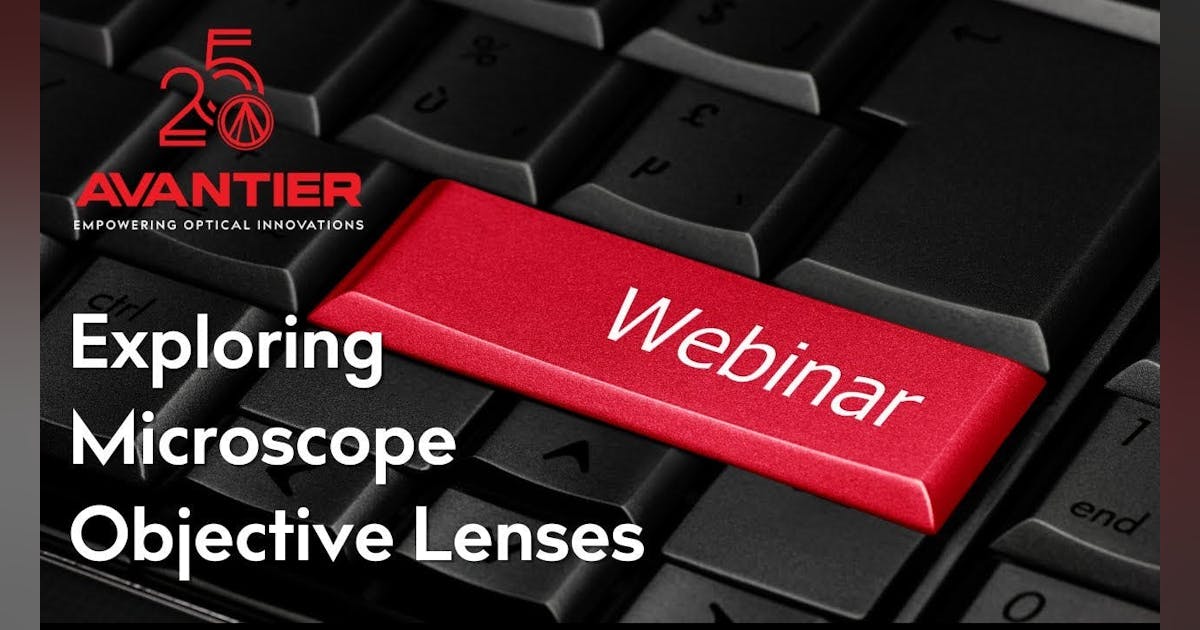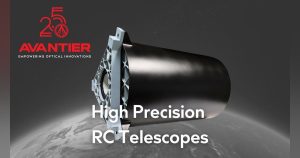Unlocking the Potential of Microscope Objective Lenses: Insights from Avantier’s Webinar
Microscopy opens the door to unseen worlds—from the intricate operations within human cells to the microengineering feats shaping future technologies. Central to these marvels are microscope objective lenses, the vital components that determine clarity, detail, and the possibilities for scientific discoveries.
Avantier, a frontrunner in optical engineering, recently conducted a compelling webinar focused on these crucial modern imaging elements. Whether you’re a seasoned researcher, enthusiastic educator, or an inquisitive individual, this guide offers a comprehensive look at the science, craftsmanship, and inspiration underlining microscope objective lenses, showing how Avantier turns vision into tangible discoveries.
Why Objective Lenses Are Essential: The Cornerstone of Every Microscope
Consider the objective lens as the ‘camera eye’ of your microscope. It is the primary point of optical contact with a sample, fundamentally responsible for magnification, resolution, and the transmission of details. A superior quality objective can transform a vague outline into a significant breakthrough, crucial in fields like neural networks exploration or material surface analysis.
Avantier’s expertise is vital across multiple disciplines such as life sciences, neuroscience, biology, cytometry, aerospace, and engineering—where clarity in imaging translates to innovation.
Exploring Lens Types: Tailoring for Each Application
Choosing the perfect objective lens is not a one-size-fits-all scenario. Here is a brief overview of the primary groups of lenses engineered to meet specific demands:
| Lens Type | Key Features & Best Uses |
|---|---|
| Achromatic | Basic correction for two colors (red, blue); standard use |
| Semi-plan Achromatic | Improved field flatness; ideal for routine microscopy |
| Plan Achromatic | Full-field sharpness; critical for quantitative research |
| Semi-apochromat | Intermediate color correction; utilized in advanced labs |
| Apochromat | Optimal chromatic and flatness correction; perfect for color-sensitive and high-resolution work |
Immersion Objectives:
- Oil Immersion: Uses a special oil for ultra-high numerical aperture and maximum resolution—ideal for examining intricate cellular details.
- Water Immersion: Water as the medium offers a higher numerical aperture than air, indispensable for live-cell imaging.
Air Objectives: Versatile and user-friendly, vital in most laboratory settings.
Avantier also customizes unique objectives like polarizing, phase contrast, and metallurgical lenses to meet specialized scientific and industrial specifications.
Key Attributes of an Exceptional Objective Lens
When selecting a microscope objective, it’s crucial to consider the following parameters:
- Magnification: Typically ranges from 1X to 100X, with 4X, 10X, 40X, and 100X being common in many labs.
- Numerical Aperture (NA): Determines the amount of detail captured; a higher NA suggests better resolution. Oil and water immersion lenses can surpass a NA of 1.0.
- Working Distance: The gap between the lens and the sample—vital for thicker specimens.
- Correction Collar: Adjusts for cover glass thickness, eliminating image blur, essential for high-NA imaging.
- Field Flatness: Plan objectives ensure clear images across the field.
- Chromatic Aberration Correction: Indicates a lens’s effectiveness in eliminating color fringing.
- Durability and Coatings: Anti-reflective and protective coatings optimize both performance and longevity.
Expert Tip: Align your objective’s abilities with your sample and imaging method. Utilizing a 100X oil-immersion apochromat for a sand grain may seem remarkable, but it’s excessive.
The Technology Behind the Lens: Avantier’s Edge
Avantier transcends being merely a manufacturer; they are partners in breakthrough advancements. Their methodology combines internal optical design, cutting-edge simulation, tailored lens crafting, and meticulous assembly. Challenges they address include:
- Custom Correction: Developing solutions for fluorescence, phase contrast, and infrared applications.
- Precision Assembly: Reducing imperfections and optimizing optical alignment, particularly for intricate multi-element apochromat objectives.
- System Integration: Avantier designs lenses to adapt or update existing microscope systems, ensuring state-of-the-art results.
This dedication to bespoke engineering empowers researchers to resolve hurdles unsolvable by standard objectives, transforming aspirational “what ifs” into determined “we accomplished it!”
Real-Life Applications: Lenses Making a Difference
Case Study 1: Neuroscience—Illuminating the Brain
A renowned neuroscience institute employed Avantier’s special apochromat lenses to chart neuronal circuits in mouse brains. Exceptional color correction and NA in these lenses disclosed image details vital for understanding synaptic links.
Case Study 2: Advanced Manufacturing—Detecting Defects
A semiconductor firm collaborated with Avantier to create metallurgical objectives for efficient wafer inspection, drastically lowering defect rates and saving millions annually.
Case Study 3: Life Sciences—Researching Cancer
In cancer research, scientists investigating tumor microenvironments utilized phase-contrast objectives, custom-built for inverted microscopes, to observe live cell cultures without dyes or stains.
Microscope Illumination: Enhancing Imaging Innovation
Objective lenses require appropriate illumination techniques for increased imaging effectiveness, as highlighted in Avantier’s webinar:
- Brightfield: Suitable for stained, high-contrast samples.
- Darkfield: Uncovers details invisible in brightfield, excellent for small, transparent specimens.
- Phase Contrast: Highlights refractive index variations, perfect for live cells.
- Fluorescence: Crucial for visualizing specific proteins or cellular components.
- DIC (Differential Interference Contrast): Adds depth, offering a “3D-like” visual.
Selecting (or designing) the right objective ensures compatibility and maximizes performance with your illumination system.
Expert Tips: Maximizing Your Objectives
- Regularly and gently clean lenses—small smudges can undermine significant optical precision.
- Ensure correct immersion media is used—mixing oil and water objectives can lead to complications and maintenance issues.
- Adjust correction collars accurately, especially at high NA.
- Seek expert guidance. Avantier offers collaborative support, whether you’re adjusting a vintage microscope or defining a unique optic for a major project.
The Human Element: Beyond Just Products
Avantier excels not merely because of its technology but through genuine passion for optics. Their knowledgeable, experienced team partners closely with clients, embracing challenges and celebrating each discovery.
Their clientele includes prestigious universities, startups, and industrial labs, with many success stories emerging from challenges initially deemed impossible—until Avantier intervened.
FAQs: Simplifying the Terminology
Q: Is a high-NA lens always necessary?
Not necessarily. While a higher NA provides better resolution, it can reduce depth of field and working distance. Balance is crucial—a robust 10X plan achromat might be all you need.
Q: How often should objectives be serviced?
Regular inspection and cleaning after intense use or when image quality declines is advised. For high-end systems, professional servicing annually is recommended.
Q: What if my need is unique?
Avantier’s specialty is custom optics, designs, coatings, and integrations—reach out for expert solutions.
The Future of Objective Lenses: A Glimpse Ahead
Future trends include adaptive optics for dynamic aberration correction, AI-powered autofocus with custom objectives, and advanced materials like fluorite for superior color fidelity. Avantier remains at the forefront, driving advances that push scientific, healthcare, and industrial limits.
Engage with the Journey: Steps Forward
If you missed the webinar, don’t worry. Access Avantier’s extensive resource library, connect with their experts, or explore their product range—from standard lenses to unique custom builds.
“Webinar attendees will leave with a profound understanding of effectively selecting and utilizing microscope objective lenses to support their research and imaging objectives.”
Let this guide serve as your introduction. Ready to view the world with new clarity? Dive deep, interact, ask questions, and embrace the opportunities that innovative optics unlock for your next leap forward.
Keywords for Readers & SEO: microscope objective lens, purchase microscope objective, microscopy lens selection, optical imaging, lens resolution, objective lens optimization, custom focus optics, phase contrast alignment, microscopy enhancement, imaging solutions, optical advances, scientific imaging, biotechnological lens innovation, custom lens creation.
For more about Avantier’s solutions, expert advice, or partnership opportunities, visit their website or contact their team—your next pivotal breakthrough could be just a lens away!













